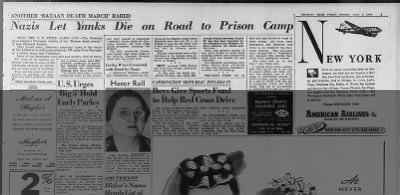- Headline
-
ANOTHER 'BATAAN DEATH MARCH' BARED
- Sub-Headline
- Nazis Let Yanks Die on Road to Prison Camp
- Publication Date
- Monday, April 2, 1945
- Historical Event
-
Eisenhower Asks Congress and Press to Witness Nazi Horrors
This database includes 1,688 articles about this event - Article Type
- Newspaper
- Page Section and Number
- 5
- Author/Byline
- UP
- Article Text
- WITH THE U. S. THIRD ARMY—(UP)—The Germans have staged a European version of the "Bataan death march," it was disclosed Sunday.
They forced many American prisoners taken in the battle of the Ardennes to walk approximately 135 miles from Bastogne to a prison camp near Frankfurt.
Many of the Americans, cold, sick and hungry, died en route. The story of the German atrocities was told by some of 800 Americans liberated at Hattanrod, 20 miles north of Friedberg.
They said the march was comparable to anything the Japanese ever made prisoners undergo.
Other American forces overran a prison camp near Reigenheim, southwest of Hassel, and rescued 1,279 Americans who tricked the Nazis into thinking they were sick.
The Yanks used soap to make themselves foam at the mouth, and they staged a mammoth "laydown" strike while the Germans marched off with 3,000 Allied prisoners, including 700 British.
The thin, poorly-fed Americans openly wept when tanks of the Sixth Armored Division rolled into the prison yard.
---
"Living Were Cremated with Dead by Nazis"
A German prison camp, near Siegenhain— American survivors of the Belgian bulge battle liberated here had lost 25 to 40 pounds a man in the three and a half months of a semi-starvation diet in German prison camps.
Equally mistreated were other nationals in the barbed wire enclosure near Siegenhain, 14 miles south of Kassel.
***
They included 2,000 British and Dominion troops, 1,000 Russians, 200 Poles.
In this area the Sixth Armored Division also freed 900 Jewish women between 16 and 35 who had been imported by the Germans from Hungary as slave laborers for farms and factories.
They told ghastly stories of sick girls unable to work being stripped, thrown into trucks with dead girls and hauled off and cremated.
The liberated Americans were taken shortly after Christmas to Bad Orb between Frankfurt-on-Main and Wuerzburg.
***
Privates were left at Bad Orb and forced to work in slate mines. All Jews were segregated and shackled and made to do whatever the Germans desired. The non-coms were transported to Siegenhain and jammed into wooden barracks with inadequate stoves.
"We were cold all of the time," one Yank said.
A typical day's menu—breakfast: One cup of tea or one cup of ersatz coffee, not both; dinner: one canteen cup of soup made of dehydrated greens or barley or peas; supper: one-sixth of a loaf of bread plus one pat of margarine (lately the bread ration was cut to one-seventh to one-tenth of a loaf per man.) - History Unfolded Contributor
- Carlos G.
- Location of Research
- Newspapers.com (https://www.newspapers.com)
Learn More about this Historical Event: Eisenhower Asks Congress and Press to Witness Nazi Horrors
- Ohrdruf (Encyclopedia Article)
- Liberation of Nazi Camps (Encyclopedia Article)
- 4th Armored Division (Encyclopedia Article)
Bibliography
Abzug, Robert H. GIs Remember: Liberating the Concentration Camps. Washington, DC: National Museum of American Jewish History, 1994.
Abzug, Robert H. Inside the Vicious Heart: Americans and the Liberation of Nazi Concentration Camps. New York: Oxford University Press, 1985.
Bridgman, Jon. End of the Holocaust: The Liberation of the Camps. Portland, OR: Areopagitica Press, 1990.
Chamberlin, Brewster S., and Marcia Feldman, editors. The Liberation of the Nazi Concentration Camps 1945: Eyewitness Accounts of the Liberators. Washington, DC: United States Holocaust Memorial Council, 1987.
Goodell, Stephen, and Kevin Mahoney. 1945: The Year of Liberation. Washington, DC: United States Holocaust Memorial Museum, 1995.
Goodell, Stephen, and Susan D. Bachrach. Liberation 1945. Washington, DC: United States Holocaust Memorial Museum, 1995.
All articles about this event
